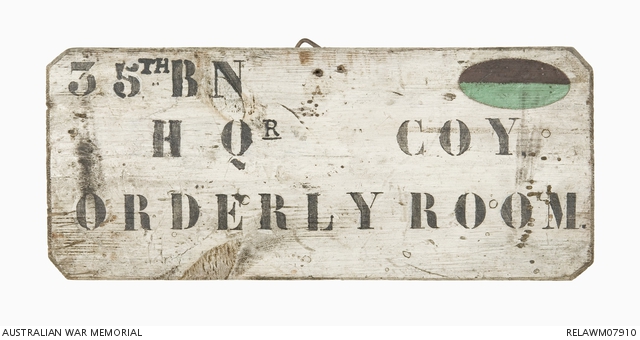| Places | |
|---|---|
| Accession Number | RELAWM07910 |
| Collection type | Heraldry |
| Object type | Heraldry |
| Physical description | Wire, Wood |
| Maker |
Unknown |
| Place made | Western Front |
| Date made | c 1916-1918 |
| Conflict |
First World War, 1914-1918 |
Orderly room sign board : 35 Battalion, AIF

Improvised sign constructed of single plank of wood painted white with bevelled edges and the corners cut at 45 degrees. '35th BN HQR COY ORDERLY ROOM' is stencilled in black letters. The white paint is considerably faded with wood starting to show through in some areas, it is also quite dirty with black smudges in areas. In the top right hand corner is a 35 Battalion colour patch, an oval split horizontally and painted black over green. There is piece of wire attached to the reverse for hanging the sign.
An orderly room is used for general administrative purposes for a battalion or company. This sign indicated the orderly room for the 35th Battalion as it served throughout France and Belgium during the First World War.
The 35th Battalion was formed in December 1915 in Newcastle, New South Wales. The battalion became part of the 9th Brigade of the 3rd Australian Division. It left Sydney, bound for the United Kingdom in May 1916. Arriving there in early July, the battalion spent the next four months training. It crossed to France in late November, and moved into the trenches of the Western Front for the first time on 26 November.
The battalion's first major battle was the battle of Messines, launched on 7 June. Their next major battle was around Passchendaele on 12 October. For the next five months the 35th alternated between periods of rest, training, labouring, and service in the line.
When the German Army launched its last great offensive in the spring of 1918, the battalion was part of the force deployed to defend the approaches to Amiens around Villers-Bretonneux. It took part in a counter-attack at Hangard Wood on 30 March, and helped to defeat a major drive on Villers- Bretonneux on 4 April.
The battalion took part in the battle of Amiens on 8 August; fought several small battles during the rapid advance that followed; and at the end of September provided reserves for the joint Australian-American operation that breached the Hindenburg Line, thus sealing Germany's defeat. The 35th Battalion disbanded in March 1919.